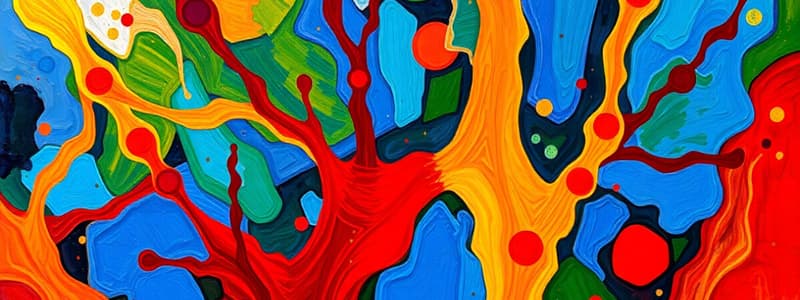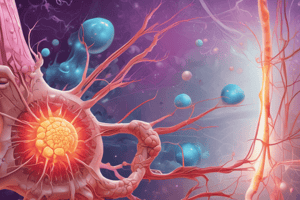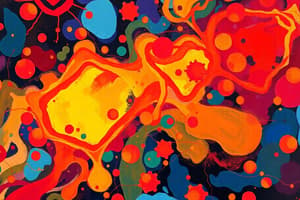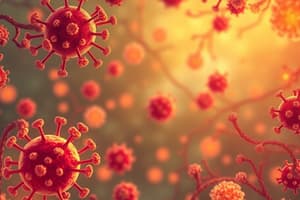Podcast
Questions and Answers
What is the primary role of the hematoma that forms after an injury?
What is the primary role of the hematoma that forms after an injury?
- To obstruct the flow of blood to the injury area
- To create a rigid structure for bone stability
- To provide immediate pain relief at the injury site
- To supply hematopoietic cells capable of secreting growth factors (correct)
What is the effect of inhibiting COX-2 during fracture healing?
What is the effect of inhibiting COX-2 during fracture healing?
- It enhances the differentiation of osteoblastic cells
- It promotes the formation of granulation tissue
- It stimulates the production of type I collagen
- It leads to repression of runx-2/osterix, critical for osteoblastic differentiation (correct)
What plays a crucial role in the terminal differentiation of chondrocytes during the remodeling phase?
What plays a crucial role in the terminal differentiation of chondrocytes during the remodeling phase?
- Wolff's law
- Parathyroid hormone-related peptide (PTHrP) (correct)
- Chondrocyte apoptosis
- Type X collagen expression (correct)
Which of the following cytokines is NOT mentioned as being released during the inflammatory phase post-injury?
Which of the following cytokines is NOT mentioned as being released during the inflammatory phase post-injury?
During the process of endochondral ossification, which type of collagen is produced first in fracture healing?
During the process of endochondral ossification, which type of collagen is produced first in fracture healing?
Which factor is NOT involved in the cartilaginous calcification process during bone formation?
Which factor is NOT involved in the cartilaginous calcification process during bone formation?
What is the relationship between the amount of callus formed and the extent of immobilization?
What is the relationship between the amount of callus formed and the extent of immobilization?
How does bone respond to mechanical stress according to Wolff's law?
How does bone respond to mechanical stress according to Wolff's law?
What process describes the degradation of the extracellular matrix during remodeling?
What process describes the degradation of the extracellular matrix during remodeling?
Which statement accurately reflects the role of VEGF in the remodeling process?
Which statement accurately reflects the role of VEGF in the remodeling process?
Flashcards are hidden until you start studying
Study Notes
Inflammation Process
- Hematoma formation occurs initially, providing hematopoietic cells that secrete growth factors.
- Macrophages, neutrophils, and platelets release cytokines such as PDGF, TNF-Alpha, TGF-Beta, and interleukins (IL-1, 6, 10, 12) detectable as early as 24 hours post-injury.
- Absence of TNF-Alpha (e.g., in HIV) delays both endochondral and intramembranous ossification.
- BMPs, fibroblasts, and mesenchymal cells migrate to the fracture site, forming granulation tissue around fracture ends.
- Granulation tissue can withstand the highest strain during fracture healing.
- Proliferation of osteoblasts and fibroblasts occurs at the fracture site.
- COX-2 inhibition (e.g., through NSAIDs) represses the expression of runx-2/osterix, essential for osteoblastic cell differentiation.
Repair Phase
- Primary callus formation occurs within two weeks after a fracture.
- If bone ends are not in contact, a bridging soft callus forms.
- Mechanical environment influences cell differentiation: stable environments promote osteoblastic lineage, while unstable environments promote chondrocytic lineage.
- Endochondral ossification transforms soft callus into hard callus (woven bone), with medullary callus enriching the soft callus.
- Cytokines are pivotal in chondocytic differentiation, and cartilage production provides provisional stabilization.
- Type II collagen (from cartilage) is produced initially, followed by type I collagen (from bone).
- The amount of callus formed is inversely proportional to immobilization extent; rigid immobilization (e.g., compression plating) promotes primary cortical healing, while closed treatment facilitates endochondral healing with periosteal bridging.
Remodeling Phase
- Commences during the middle of the repair phase and persists after clinical union.
- Chondrocytes undergo terminal differentiation influenced by signaling pathways such as Ihh, PTHrP, FGF, and BMP.
- Hypertrophic chondrocytes express Type X collagen as the extracellular matrix undergoes calcification.
- Proteases are responsible for degrading the extracellular matrix.
- Cartilaginous calcification occurs at the junction of maturing chondrocytes and the forming bone.
- Multiple factors are expressed during bone formation, including TGF-Betas, IGFs, and collagen types I, V, and XI.
- Following this, chondrocytes undergo apoptosis, and VEGF production stimulates new blood vessel invasion.
- Remodeling of newly formed woven bone occurs through coordinated osteoblastic and osteoclastic activity.
Bone Remodeling Influences
- Wolff's law states that bone remodels in response to mechanical stress.
- Piezoelectric charges impact remodeling: the compression side of bone is electronegative, stimulating osteoblast formation, while the tension side is electropositive, stimulating osteoclast activities.
Studying That Suits You
Use AI to generate personalized quizzes and flashcards to suit your learning preferences.




